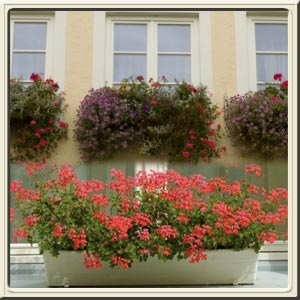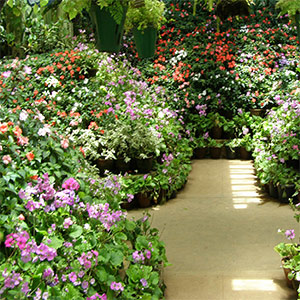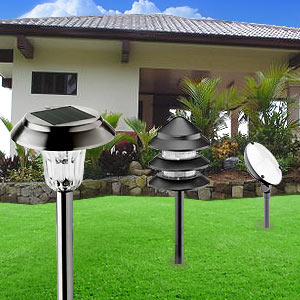Window Garden

Whether you live in houses with plenty of backyard space or in a high-rise apartment, you can still make plants and greenery a part of your lifestyle. Indoor garden is a great option whereby you can easily bring nature into your living room.
An indoor kitchen garden will lend you the pleasure of verdant green plants on your window sill. You can opt for window boxes filled with flowers or ceramic pots with luscious tomatoes or containers filled with your favorite herbs. Try getting yourself a window garden and watch how it can transform a drab kitchen setting or staid terrace or balcony.
Window box garden
Typically, a window box is a container for growing plants and is positioned outside a window and supported in place by brackets on the wall below. Window boxes are mostly used by apartment dwellers on higher floors that do not otherwise have access to a garden or place to grow plants and flowers. The plants can be seen by those inside the property as well as those outside.
Access for planting and maintenance can be via the window from indoors. The box can also be placed inside a kitchen window in order to grow herbs or other supplies. The plants thrive on the sunlight and fresh air which is available in plenty near the windows. Besides, your house also looks cool and beautiful with boxes full of fresh flowers and herbs.
The latest variant of the window box is the self hydrating variety wherein the box is equipped to water the plants. It features a reservoir lined with a fabric wick to moisten soil and feed plants where they need it most – from the roots up. Rolling casters and wheels are included for easy movement. Window boxes can be chosen in wood, plastic, metal, fiberglass and terra cotta. You can think of placing vines like cucumbers on a trellis.
Flowers such dianthus, sweet alyssum, candytuft, petunia, heliotrope, or sweet pea lend your home a wonderful fragrance. Have fun creating a window garden with asparagus ferns, bulbs, tickseed, ferns, coral bells, plantain lilies, lavender, purple fountain grass and pansies. Combine plants that help each other by balancing their proportion.
Drainage is an important factor to be considered when you are buying a window box. You can choose between containers that have drainage trays attached and those that have separate drainage trays. Drainage mats are included in some boxes, in which case there is no need to add gravel or drainage material at the bottom.
Simply add your soil mixture directly on top of the mat. You will be the main source of water, compost and fertilizer provider for your window box. Unless you are growing something with special needs, it is best to opt for a general purpose fertilizer and any normal compost available at any good gardening store. You can either choose a slow release or a water soluble fertilizer.
While buying a window box, take care that the size is appropriate for your window. While boxes are available in various sizes, it is better to go for ones that are a little wider than the actual window. The style of the window box should match the architectural style of your home. While planting, aim for more shape in the design by using a mixture of plants in a zigzag pattern, varying in sizes and texture.
This will give a bountiful, lush look. Use the tallest plants in the back, the short and the bushy types should go in the middle rows and the front of the box should be planted with trailers to give your box the overflowing effect that is quite gorgeous.
Do keep in mind the weather pattern. If your window area is too windy, then you can opt for sturdy, bushy plants. The type of plant will also depend on how much sunlight your window garden will receive. While planting, it is always best to start from the center of the box and work your way out. During the hot summer months, it is advisable to water the plants often. You can also use the drip irrigation system available at some garden centers. Don’t forget to remove spent blooms, as decaying flowers and leaves left on nearby soil may encourage bacterial growth.
Kitchen Garden
Herbs are well suited to indoor cultivation and what better place to plant then than the kitchen window sill. You can water them regularly and toss a few into your dishes and enjoy their aromatic fragrance and medicinal benefits. Choose and plant herbs that will complement those dishes. For example, if you love tortellinis or potato leek soup, you can opt for parsley. Once, you have decided what to plant, you can decide whether you want to use seeds or seedlings.
The best type of soil to use for window herbs is a mixture of potting soil, peat moss and perlite. This mixture is available in most garden stores. Containers should not be problem as plastic window boxes, clay window boxes, clay pots, half barrels or even the old teapot! Punch drainage holes into their bases and your containers are ready to be planted with a variety of herbs. Most of the herbs require at least 4 hours of sunlight everyday.
Before planting the seeds, soak them in water for 2-4 hours. Fill the containers with potting soil. If planting seeds, sprinkle them over the soil and cover them with ¼ inch of soil. Good choices for direct seeding include compact dill, basil and Greek oregano. If you are planting seedlings, dig a small hole and bury their roots in the soil so that they are at the same depth that they were previously growing in. If you are planting more than one seedling in the same container, maintain at least a distance of 2 inches between them. You can plant thyme, mint and rosemary directly as seedlings.
If you are going to plant more than one type of seed in the same box, designate separate areas for each type of herb. Water the garden thoroughly, so that moisture escapes from the drainage holes and place the plants in a warm spot. Whenever the soil feels dry to touch, water the container to keep the kitchen garden herbs well hydrated. Once the seeds begin to germinate, be careful not to over water, as this can cause the roots to rot. The plants should have plenty of light but protect them from extremities in temperature.
If you feel that light is limited, then rotate the containers once a week so that all the plants may get equal sunshine. If a large number of seeds germinate, snip the plants at soil level, rather than pulling them out of the soil. This thinning is necessary to avoid overcrowding. Once the herbs start growing, you can harvest them, but be sure to leave at least a sprig of each herb so that the plant can continue to grow. Trimming herbs encourages them to grow bushy. Sit back and enjoy the fresh herbs which will spice up your meal.
With an active indoor herb garden and a beautiful window flower box, you don’t have to cope with working outside in the summer heat or worry about dogs and other pests digging up your gardens. After all, there could be nothing more comforting than a garden that gives sustenance to both body and soul.
Top of the Page: Window Garden
Tags:#kitchen window garden #kitchen garden

Eco Friendly Homes
Garden Maintenance
Organic Gardening
Vegetable Garden Layout
Xeriscaping
Hydroponics Gardening
Feng Shui Garden
Ornamental Plant
Container Garden
Growing Succulents Indoors
Landscape Design Idea
Herb Garden Design
Window Garden
Lawn Mowing
Lawn Maintenance Tips
Orchid Care
Bonsai Tree
Cactus Plant
Thanksgiving Cactus
Rock Garden
Gardening Accessories

Bird Feeder
Leaf Blower
Solar Bird Bath
Lawn Sprinkler System
Outdoor Garden Furniture
Garden Fountain
Butterfly Garden
Electric Lawn Mower
Garden Pond
Landscaping

Landscaping
Landscape Lighting
Outdoor Canopy
Solar Garden Lights
Garage Plan
Home Improvement
Home Furnishing
Home Improvement Catalog
Feng Shui
Top of the Page: Window Garden
Popularity Index: 101,425

